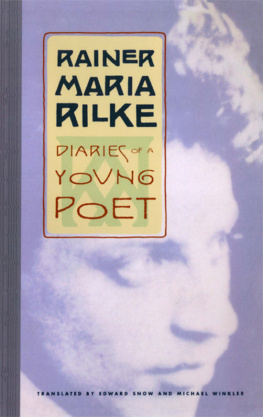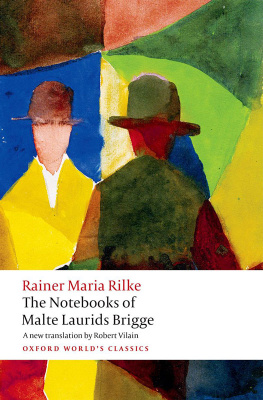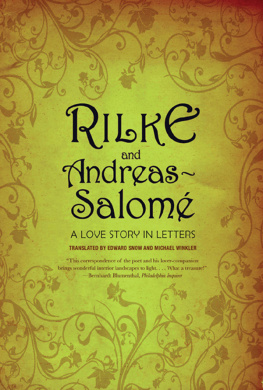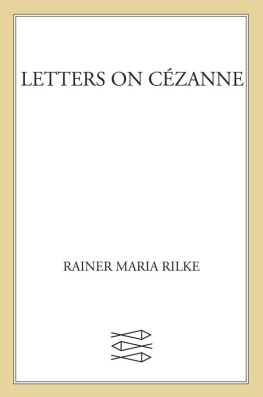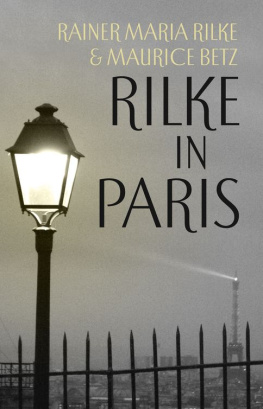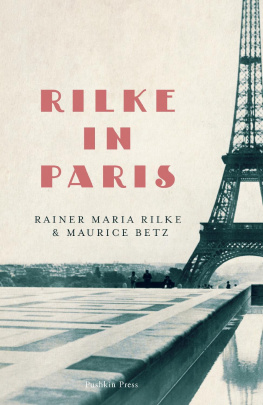
RAINER
MARIA
RILKE
DIARIES
OF A
YOUNG
POET
TRANSLATED AND ANNOTATED BY
EDWARD SNOW AND MICHAEL WINKLER


W. W. NORTON & COMPANY NEW YORK LONDON
BETWEEN 15 APRIL 1898 AND 22 DECEMBER 1900 Rainer Maria Rilke wrote three diaries that span a crucial period in his artistic growth. At the beginning of this phase the young poet had perfected, if not yet exhausted, the rhetorical techniques and mannerisms of his early, impressionistic style. His verse was still prone to the gossamer and was given more to a flirtation than a sustained artistic engagement with the exquisite and the delicate. Thus it often enough veiled its extraordinary sensitivity to nuances of mood and perception in an ethereality that could easily slide into preciosity and tended to sacrifice simplicity and clarity of purpose to this very perfection of a method. But Rilke had come to realize only too well that he needed to constrain his busy games of make-believe and learn how to control his ingenious lyricism. This made it necessary, most of all, to free himself from the rapturous self-indulgence that could spin mellifluous lines and intricate rhymes with prolific ease. He had to submit himself to the kind of self-discipline that comes with the ascetic solitude of regular, arduous work.
Rilkes three early diaries reflect this search for a language that might capture the specificity of things natural and crafted and at the same time convey their intrinsic spirituality. They chronicle, in other words, the emergence of the sachliche Sagen, the objective and visually precise language that will come to characterize his poetry of things. At the same time they are very different books. Each has a distinct rhetorical style and a persuasive purpose of its own. Yet they complement each other, even as they confound our expectation that they might reveal intimate details from the poets daily affairs. Rilkes diaries do maintain a certain chronological flow, albeit one with breaks and longer interruptions, but they are not directly the immediate account of a specific time; it is not their intent to record the minutiae of day-to-day life. For this reason, they have not become identified by their chronology. Rather, they are usually titled after three places where Rilke lived and, at least for a time, felt at home: Florence (and the Tuscan countryside), the village of Schmargendorf just outside of Berlin, and Worpswede, an artists colony in the moors near Bremen.
Yet each of these places also marks a significant turning point, one that may be identified by a personal crisis to which Rilke responded, as he was wont to do throughout his life, with a sudden flight. These precipitous departures (in two instances immediately preceded by rapturous expressions of at-homeness) are impossible to reduce to a single cause. This is especially true of his sudden decision to leave Florence for Viareggio. The justification he gives for this unsettling retreathis disgust with riotous youths throwing stones into the Loggia dei Lanzisurely hides more than it explains and leaves unarticulated (in a diary of all places) what must have been a painful blow to his sense of self-worth as a poet. His abrupt departure for Worpswede (halfway through the Schmargendorf Diary) was no doubt motivated in part by tensions in his relationship with Lou Andreas-Salom that had intensified toward the end of their trip to Russia, and his equally headlong return to Schmargendorf (halfway through the Worpswede Diary) must have had something to do with the news of Paula Beckers secret engagement to her teacher and their mutual friend, Otto Modersohn. These spontaneous moves signal reversals and ruptures in Rilkes private affairs that have shaped the particular character of these three diaries. But the precise manner in which the concatenation of impulses and reasons worked as a motivating force remains elusive and perhaps was not clear even to the diarist himself.
That we should have diaries from Rilke in any form is on first consideration surprising. Rilke was as averse to publishing anything autobiographical as he was to exposing the fragility of his mental constitution in a confessional posie du coeur. He was more likely to seek a sense of calm maturity, which he considered the disposition necessary for beginning a diary, by honing his talent for precise observation and visually vivid depiction. He also had become aware of how strongly his writing needed to reach a responsive companion. This dialogic urge makes its presence felt more as an animating, compulsive energy than as an argumentative voice with fixed convictions. It is a significant and underappreciated aspect of his art. Perhaps even more openly than in his letters, its prevalence is evident in the rhetorical structure of these other-oriented diaries.
The person to stimulate this kind of discursive sociability in Rilke was a woman nearly fifteen years his senior, Lou Andreas-Salom. When Rilke met her she was already an accomplished writer with a considerable reputation that derived from perceptive books on Ibsen and Nietzsche, from a variety of essays on contemporary issues, and from her fictional work, much of it an autobiographical exploration of female psychology. Rilke approached her with subtle determination, first by sending her poems anonymously, then with an epistolary masterpiece of seductive insinuation (dated 13 March 1897) that speaks of their shared interest in the workings of religious creativity. When they met, on 12 May 1897, she was thirty-six, he, twenty-two. They were attracted to each other at first sight, discreetly became lovers, and remained close companions for nearly three years. Their attachment survived Rilkes marriage to Clara Westhoff and endured as an ever deepening friendship for the rest of their lives. It was a liaison that also yielded what is perhaps Rilkes single most important correspondence.
It was under Lous tutelage that Ren became the poet Rainer Maria Rilke. She made him shed the eccentricities of the young genius, and curtail his propensity for turning everything about and around his own person into quickly improvised verse. Her own mental regimen included keeping a diary, as an incentive to formulate impressions and remembrances accurately and as a way of communicating with a soul mate during and after a temporary separation. She had recorded, for example, her conversations with Nietzsche in 1882 in a journal written specifically for her friend Paul Re, and unlike Rilke, she wrote a diary of their travels through Russia during July 1900.
When she sent Rilke off to Florence in April 1898ostensibly so that he might experience on his own, directly and differently, what his assiduous studies of Italian art had prepared him to seeit was with the understanding that he would bring her back a diary. It is impossible to say, however, exactly what kind of a diary she encouraged, or perhaps even commissioned, Rilke to write. Was it to be a specific, coherently inclusive description of how the citys historical ambience and its prominent as well as ubiquitous works of art affected him? A refined travelogue that would show Rilkes control over a bewildering variety of impressions? Did she also expect a penetrating account of his social experiences, especially those with connoisseurs of art, that might challenge and sharpen his own perceptions? Was it to be a self-analytical record, a probing of his responses to conflicting stimuli and unique encounters for the purpose of clarifying the complex interaction of his senses and psyche with an objective reality that is constantly in flux? We are left with little more than speculations. But it is very likely that Rilke had to overcome, at least initially, strong misgivings about the (conventional) diary as a literary genre, that he had doubts, at least, about the apparent randomness of its material and about the unpolished spontaneity of its style.
Next page
